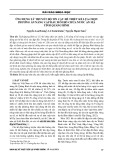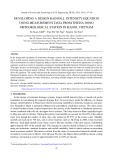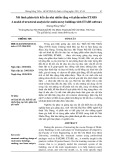
34 Hoang Phuong Hoa
DAMPING EFFECT OF DOUBLE FRICTION PENDULUM BEARINGS FOR
CIVIL BUILDINGS SUBJECTED TO EARTHQUAKES CONSIDERING
VERTICAL EXCITATION FORCES
Hoang Phuong Hoa*
The University of Danang - University of Science and Technology, Vietnam
*Corresponding author: hphoa@dut.udn.vn
(Received: September 12, 2024; Revised: October 05, 2024; Accepted: October 14, 2024)
DOI: 10.31130/ud-jst.2024.517E
Abstract - Earthquakes pose significant threats to humanity, with
recent years witnessing an increase in both the intensity and
frequency of seismic events worldwide. To mitigate the damage
caused by earthquakes, various techniques have been developed.
This article focuses on the application of Double Friction
Pendulum (DFP) bearings for base isolation in three-story steel
construction projects. The authors develop a system of
differential equations describing the motion of the structural
system equipped with DFP bearings. The Runge-Kutta numerical
method, specifically the ode15s function in MATLAB, was used
to solve these equations. The results of the calculations provide a
comparison of the damping efficiency of the structural system
with and without the use of DFP bearings, assessing the
effectiveness of vibration isolation during an earthquake, with
three components X, Y, and vertical considered.
Key words – Earthquake; structural control; base isolation;
double friction pendulum bearings.
1. Introduction
The world has experienced many earthquake disasters.
Some of the earthquakes that have occurred have caused
great damage to people and property. The Tohoku
earthquake of about 9 on the Richter scale caused a tsunami
in Japan on March 11, 2011, causing estimated damage of
about 360 billion USD. On June 2, 2023, a 7.8-magnitude
earthquake in Turkey killed more than 55,700 people and
collapsed many houses and bridges. Recently, at 11:35 on
July 28, 2024, an earthquake with an epicenter in Kon
Plong district, Kon Tum province, Vietnam with a
magnitude of about 4.8 to 5 on the Richter scale made us
feel it very clearly when we were several hundred
kilometers away from the epicenter.
To minimize the damage caused by earthquakes to
construction works such as bridges, roads, houses, dams,
etc., the design of earthquake-resistant structures is an
important task for design engineers. According to the
modern design perspective, the concept of earthquake-
resistant structural control has been proposed and divided
into 3 main types: Active structural control; Passive, and
Semi-Active. In this article, the author will introduce
passive earthquake-resistant structural control techniques,
using measures to isolate the structure's vibrations from the
ground acceleration of earthquakes [1, 2].
For an earthquake to occur, the source of the vibrations
is called the focus, while the point directly above it on the
Earth's surface is known as the epicenter. The distance
from the focus to the epicenter is referred to as the depth of
the earthquake. An earthquake is classified as shallow
when the focus is located at a depth of approximately
70 km or less. For example, the Gorkha earthquake that
struck Nepal on April 25, 2015, measured 7.8 on the
Richter scale and had a depth of 15 km, classifying it as a
shallow earthquake.
In the past, due to various reasons such as limited
calculation tools and the relatively minor impact of vertical
shaking forces on structures, this influence was often
overlooked. However, advances in technology and
calculation equipment have changed this perspective. It is
now understood that structures located near the epicenter
are more significantly affected than those farther away. As
a result, scientists believe that the influence of vertical
shaking forces on structures near the epicenter is an
important factor that must be considered.
This paper investigates the impact of vertical excitation
forces on the motion and damping performance of
structures mounted on Double Friction Pendulum Bearings
(DFP), as illustrated in Figure 1.
The DFP bearing was calculated in detail for the bearing
motion by D.M. Fenz in the research group of M.C
Constantinou [3, 4] in 2006 and completed in 2008. The DFP
bearing consists of two curved surfaces of radius R1, and R2
and a pendulum sliding on the two curved surfaces with
friction coefficients
12
. The horizontal displacement
capacity of the bearing dout = d1 + d2 (Figure 1).
Figure 1. Cross section of DFP pillow
Studies on the influence of vertical earthquake
excitation forces on construction are still quite limited. In
Vietnam, a research group led by Hoa et al. conducted a
study in 2021 [14] that examined the impact of vertical
excitation forces in a general model applied to an 11-story
steel frame. Additionally, Nam et al. investigated the
influence of vertical excitation forces specifically for SFP
friction sliding pendulum bearings [9].
Some foreign authors, such as Faramarz et al. [15],
studied earthquake-resistant friction sliding double-surface

ISSN 1859-1531 - THE UNIVERSITY OF DANANG - JOURNAL OF SCIENCE AND TECHNOLOGY, VOL. 22, NO. 11B, 2024 35
bearings in 2010 for structures located near and far from
the epicenter. Their research findings indicated that
structures near the epicenter experience greater seismic
forces than those located farther away. In 2019, Zhou et al.
[16] examined the theoretical movement of DFP bearings
while considering the vertical excitation force of
earthquakes. Additionally, experimental research on a
scaled 5-story steel structure model conducted by a
research group led by Dao [17, 18] at the University of
Nevada, USA, demonstrated that the influence of the
vertical excitation force is significant and warrants
attention.
It is evident that both domestic and foreign research
primarily focuses on high-rise buildings or structures with
large weights. However, many civil works, including the
headquarters of small and medium-sized enterprises in
Vietnam, are currently being built as 3 to 5-story buildings,
and proper seismic design considerations for these smaller
structures are lacking. This article will focus on studying
the damping effect of friction-slip double-sided pendulum
bearings, taking into account the vertical excitation force
for low-rise buildings that are increasingly common in
Vietnam, yet have not received adequate attention from
designers and seismic design standards.
2. Structural calculation model with DFP bearings
2.1. Equation of motion [5, 6]
The DFP bearing has 2 friction elements. The first
element is the sliding on surface 1 with the physical
characteristics: mass mb1, stiffness kb1, friction coefficient
, and sliding capacity d1. The second element is the
sliding on surface 2 with the physical characteristics: mass
mb2, stiffness kb2, friction coefficient
, and sliding
capacity d2.
Connecting the model of DFP bearing and the structure,
we have the structural model with DFP bearing as shown
in Figure 2. The system will have (n+2) degrees of
freedom.
Figure 2. Calculation model of seismic isolation structure using
DFP bearings
The stiffnesses kb1 and kb2 are determined from the
restoring force component of the sliding equation,
respectively on surfaces 1 and 2 as follows:
1
1
2
2
b
eff
b
eff
W
kR
W
kR
=
=
()
where: W is the total weight above the bearing, Reff1 is the
effective radius of curvature of sliding surface 1 and Reff2 is
the effective radius of curvature of sliding surface 2.
Mass mb2 is the mass of the second sliding surface and
mb1 is the mass of the pendulum (usually has a very small
value). The mass is determined equivalent to the mass of a
floor, denoted by mi (i from 1 to n floors). The system of
differential equations of motion of the seismic isolated
DFP bearing structural system subjected to ground
acceleration
g
u
including (n+2) equations, is written as
follows:
1 1 1 1 1 1 2 1 2 2 2
2 2 2 2 1 2 2 1 2 1 1 2 1
1 1 1 1 2 1 1 2 2 1 2 2 1 2
( ) ( ) 0
( ) ( ) ( ) ( ) 0
( ) ( ) ( ) ( ) ( ) 0
...
( ) (
b b g b b f r b b b f r
b b g b b b f r b b
g b b
n n g n n
m u u k u F F k u u F F
m u u k u u F F k u u c u u
m u u k u u c u u k u u c u u
m u u k u u
+ + + + + − − − =
+ + − + + + − + − =
+ + − + − + − + − =
+ + − 11
) ( ) 0
n n n n
c u u
−−
+ − =
(2)
The frictional force components on the curved surfaces
in equation (2) are determined as follows:
1 1 1
2 2 2
f
f
F WZ
F WZ
=
=
(3)
in there:
max max min
()
u
e
−
= − −
(4)
with
max and
min being the coefficients of friction
corresponding to the largest and smallest sliding velocities,
(s/m) being a constant depending on the surface pressure
corresponding to each material, and 𝑢 being the sliding
velocity. The value of function Z is determined from the
differential equation (5).
10YZ u Z Z uZ Au
−
+ + − =
(5)
Combining the Bouc-Wen model and experiments,
Constantinou et al. proposed a model to determine the
friction force in sliding bearing devices with high
precision, specifically the friction coefficient is determined
in equation (4), and the friction force is determined in
equation (6). The constants in equation (5) including A, Y,
and
are also determined by the author from
experiments [10, 11].
f
F WZ
=
(6)
The impact force components are determined by
equation (7).
1 1 1 1 1 1 1
2 2 2 1 2 2 1 2 1 2
( ) ( ) ( )
( ) ( ) ( )
r r b b b
r r b b b b b b
F k u d sign u H u d
F k u u d sign u u H u u d
= − −
= − − − − −
(7)
The system of differential equations of motion (2) will
be solved by the fourth-order Runge-Kutta numerical
method (using the ode15s function in Matlab) to determine
the response of the structure and DFP.
2.2. Effect on vertical ground acceleration
For structures located near the epicenter, the reality
shows that the influence of the vertical excitation force
(perpendicular to the plane created by X and Y) is often
much greater than that of structures located far from the
epicenter. Therefore, when considering the vertical
excitation component, the total weight above the bearing
W will change (plus the inertial force component caused
by the vertical ground acceleration Az [7, 8, 9]. When
DFP Bearing

36 Hoang Phuong Hoa
considering the vertical excitation force, we consider the
entire structure above as a rigid block with a variable
weight V (t) and determined as follows:
( )
W1 gz
t
a
Vg
=+
(8)
in which:
gz
a
is the vertical acceleration component of the
ground (creating the vertical excitation force), and g is the
acceleration of gravity. We see that in equation (8) if we do
not consider the vertical acceleration of the ground
(
gz
a
= 0), V(t) is equal to W of the structural system again
as calculated in the plane created by the X and Y axes.
3. Numerical example analysis
To illustrate the structural behavior through the above
mathematical model and evaluate the damping efficiency
of the seismic isolation device, a numerical example is
analyzed as follows.
The assumed analysis structure is a three-story steel
building. The technical parameters are presented in Table 1.
Table 1. Structure parameters
Parameter
Symbol
Unit
Value
Damping ratio
%
5
Stiffness of each floor
ki
kN/mm
60
Mass of each floor
mi
kNs2 /mm
0.513
Time period
T1
S
0.713
The specifications of the DFP bearings selected in this
analysis are shown in Table 2.
Table 2. DFP parameters
Parameter
Symbol
Unit
Value
Slide radius 1
R 1
mm
3000
Slide radius 2
R 2
mm
3000
Height from the radius of
curvature of the sliding
surface 1 to the center of the
spindle (Figure 1)
h 1
mm
40
Height from the radius of
curvature of the sliding
surface 2 to the center of the
spindle (Figure 1)
h2
mm
60
Horizontal travel of bearing
for sliding surface 1
d1
mm
500
Horizontal travel of bearing
for sliding surface 2
d2
mm
500
Coefficient friction of sliding
surface 1
1
-
0.04-
0.06
Coefficient friction of sliding
surface 2
-
0.06-
0.08
Correction factors
A
-
1
Y
mm
0.25
Γ
-
0.9
Β
-
0.1
Η
-
2
Friction coefficient correction
parameter
s/mm
0.02
The ground acceleration data is the actual acceleration
tape of the Northridge earthquake taken from [12]. The
horizontal acceleration profile is shown in Figure 3. The
peak acceleration of this acceleration tape is 0.874g.
Figure 3. Horizontal ground acceleration
This earthquake had a very large vertical component,
the vertical PGA value was 0.958g. The vertical
acceleration profile is presented in Figure 4.
Figure 4. Vertical ground acceleration
To see the dominant period of the accelerating band, the
response spectrum is analyzed as illustrated in Figure 5.
The dominant period of this accelerating band is near the
region 0.7 s.
Figure 5. Response spectrum of horizontal acceleration
3.1. Evaluation of seismic insulation performance of
DFP bearings
Time history analysis of the model for the case of
ignoring vertical ground acceleration was performed using a
numerical solution. The response of absolute deceleration
efficiency for the first and third floors is plotted in Figures 6
and 7, respectively. The deceleration efficiency on the third
floor is particularly impressive, at approximately 93%.
Figure 6. Acceleration reduction efficiency of the first floor
Figure 7. Acceleration reduction efficiency of 3rd floor
Time (s)
ax(g)
Time (s)
az(g)
Time (s)
Acceleration, a1(g)
Seismic Isolation Structure
Rigid Structure
Time (s)
Acceleration, a3(g)
Seismic Isolation Structure
Rigid Structure

ISSN 1859-1531 - THE UNIVERSITY OF DANANG - JOURNAL OF SCIENCE AND TECHNOLOGY, VOL. 22, NO. 11B, 2024 37
The shear force reduction efficiency in the first and
third floors is shown in Figures 8 and 9, respectively. In
which, the shear force reduction efficiency in these two
floors is 92% and 88%, respectively.
Figure 8. Shear force reduction efficiency of 1st floor
Figure 9. Shear force reduction efficiency of 3rd floor
3.2. Evaluation of the influence of vertical ground
acceleration
Conduct model analysis while considering the vertical
ground acceleration component. The results show that
absolute acceleration in the floors tends to increase, with
the first floor increasing by 9.29% and the third floor
increasing by 4.57%. These results are illustrated in
Figures 10 and 11.
Figure 10. Effect of vertical ground acceleration on absolute
acceleration of 1st floor
Figure 11. Effect of vertical ground acceleration on absolute
acceleration of 3rd floor
The influence of the vertical acceleration component on
the floor shear force is very clear, as shown in Figures 12
and 13. The first floor increased by 41.85%, while the third
floor increased by 24.81%. The calculation results indicate
that the shear force, when considering the vertical
excitation force, acts along the column body of the
structure. When designing the column system of a building,
engineers typically design it to withstand compression and
moment; thus, the vertical excitation force does not
significantly affect the potential for structural failure.
However, it is important to note that the base shear force
of the structure increases by more than 40%, providing a
valuable reference for designers.
Figure 12. Effect of vertical ground acceleration on first floor
shear force
Figure 13. Effect of vertical ground acceleration on 3rd floor
shear force
The effect of vertical acceleration on the bearing
displacement also showed an increase but not significant,
approximately 6.77 %, shown in Figure 14.
Figure 14. Effect of vertical ground acceleration on bearing
displacement force
DFP bearings are designed primarily to isolate ground
vibrations in the horizontal direction. According to the
calculation results shown in Figure 14, although the
influence of vertical excitation force is minimal, it is
important to note that if vertical excitation is considered,
the acceleration value of the structure increases. This is
crucial, as designers or seismic design standards that ignore
this value may overlook factors that affect the safety of the
structure.
4. Conclusion
Isolating earthquake vibrations for construction works
is a popular technique nowadays. The technique of using
DFP friction sliding double-sided bearings to isolate
vibrations caused by ground acceleration when an
earthquake occurs has brought high efficiency when
considering the earthquake-resistant 3-story building
structure and the vertical excitation force as an example.
Through the results of numerical analysis, we see that:
For horizontal damping efficiency, the acceleration
reduction efficiency of the 3rd floor of the building is up to
about 93%, and the shear reduction efficiency of the 1st
Time (s)
Shear Force, F1(103kN)
Seismic Isolation Structure
Rigid Structure
Time (s)
Time (s)
Shear Force, F3(103kN)
Seismic Isolation Structure
Rigid Structure
Time (s)
Acceleration, a1(g)
Time (s)
Acceleration, a3(g)
Time (s)
Shear Force, F1(103kN)
Time (s)
Shear Force, F3(103kN)
Bearing Displacement, Ub(mm)
Fb/W

38 Hoang Phuong Hoa
floor is about 92%, while the 3rd floor is about 88%.
For vertical efficiency, there is a tendency to increase,
in which the first-floor increases by 41.85% and the third
floor increases by 24.81%, a significant increase that we
cannot ignore. However, when considering the vertical
excitation force, the displacement of the bearing does not
increase much; according to the calculation, it is only about
6.77%, which is consistent with reality because the
structure of the seismic isolation bearing mainly allows
(controls) the structure to have horizontal displacement
without collapsing when a strong earthquake occurs.
REFERENCES
[1] I. G. Buckle and R. L. Mayes, “Seismic isolation: history,
applications, and performance-a world view”, Earthquake Spectra,
vol. 6, no. 2, pp. 161-201, 1990.
[2] C.S. Tsai, T.C. Chiang, C.K. Cheng, W.S. Chen, and C.W. Chang,
“An Improved FPS Isolator for Seismic Mitigation on Steel
Structure”, In ASME 2002 Pressure Vessels and Piping Conference,
American Society of Mechanical Engineers, 2002, pp. 237-244.
[3] D.M. Fenz and M.C. Constantinou, “Behavior of the double concave
Friction Pendulum bearing”, Earthquake Engineering and
Structural Dynamics, vol. 35, no. 11, pp. 1403-1424, 2006.
[4] D.M. Fenz and M.C. Constantinou, “Mechanical behavior for Multi-
Spherical Sliding Bearings”, Technical Report MCEER-08-0007,
Multidisciplinary Center for Earthquake Engineering Research,
University at Buffalo, State University of New York, Buffalo, NY, 2008.
[5] A. Hamidreza, et al., “Effectiveness of seismic isolation for long-
period structures subject to far-field and near-field excitations”,
Front. Built Environment, vol. 6, no. 2020, pp. 24, 2020.
[6] N. V. Nam, H. P. Hoa, and N. H. Vinh, “Model of friction bearing
types in earthquake-resistant structures: DFP and TFP bearings”,
Proceedings of the National Conference on Engineering Mechanics,
Danang University, ISBN 978-604-84-1273-9, 2015, pp. 487 - 494.
[7] N. V. Nam, “Frictional sliding isolation bearing structure model for
earthquake resistant structures”, Ph.D. dissertation at Danang
University, 2016.
[8] H. P. Hoa, N. V. Nam, and D. C. Thuat, Earthquake and earthquake-
resistant structural control techniques, Construction Publishing
House. ISBN: 978-604-82-2058-7, 2017.
[9] N. V. Nam, H. P. Hoa, and P. D. Hoa. “Effectiveness of SFP seismic
isolation bearings for high-rise buildings subjected to earthquakes
considering vertical excitation components”, Construction Journal.
ISSN 0866-0762, no. 3, pp. 34-36, 2016.
[10] M. Constantinou, A. Mokha, and A. Reinhorn, “A. Teflon bearings
in base isolation II: Modeling”, ASCE Journal of Structural
Engineering, vol. 116, no. 2, pp. 455-474, 1990.
[11] A. Mokha, M. Constantinou, and A. Reinhorn, “Teflon bearings in
base isolation I: Testing”, ASCE Journal of Structural Engineering,
vol. 116, no. 2, pp. 438-454, 1990a.
[12] University of Berkeley, “Pacific Earthquake Engineering Research
Center - PEER ground motion database”, PEER Center, [Online].
Available: http://ngawest2.berkeley.edu [Accessed: Sep. 27, 2023].
[13] S. Gorai and D. Maity, “Numerical investigation on seismic
behavior of aged concrete gravity dams to near source and far source
ground motions”, Nat. Hazards, vol. 105, pp. 943-966, 2021.
[14] H. P. Hoa Hoang, P. H. Nam, and N. V. Nam, “On the influence of
the vertical earthquake component on structural responses of High-
Rise buildings isolated with Double friction pendulum bearings”,
Appl. Sci., vol. 11, pp. 3809, 2021.
[15] K. Faramarz and R. Montazar, “Seismic response of double concave
friction pendulum base-isolated structures considering vertical
component of earthquake”, Adv. Struct. Eng., vol. 13, pp. 1-13,
2010.
[16] F. Zhou, W. Xiang, K. Ye, and H. Zhu, “Theoretical study of the
double concave friction pendulum system under variable vertical
loading”, Adv. Struct. Eng., vol. 22, pp. 1998-2005, 2019.
[17] D. D. Nhan and K.L Ryan, “Computational Simulation of a Full-
Scale, Fixed-Base, and Isolated-Base Steel Moment Frame Building
Tested at E-Defense”, ASCE Journal of Structural Engineering, vol.
140, no. 8, pp. A4014005, 2014.
[18] D. D. Nhan, K.L Ryan, E. Sato, and T. Sasaki, “Predicting the
displacement of triple pendulum™ bearings in a full-scale shaking
experiment using a three-dimensional element”, Earthquake
Engineering & Structural Dynamics, vol. 42, no. 11, pp. 1677-1695,
2013.


















![Bài giảng Quản lý vận hành và bảo trì công trình xây dựng [chuẩn nhất]](https://cdn.tailieu.vn/images/document/thumbnail/2025/20251006/agonars97/135x160/30881759736164.jpg)







